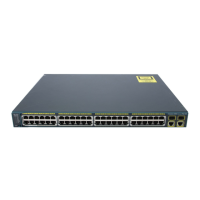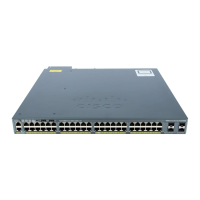are received in a configured time period, the receiver port is removed from multicast group membership. With
Immediate Leave, an IGMP query is not sent from the receiver port on which the IGMP leave was received.
As soon as the leave message is received, the receiver port is removed from multicast group membership,
which speeds up leave latency. Enable the Immediate-Leave feature only on receiver ports to which a single
receiver device is connected.
MVR eliminates the need to duplicate television-channel multicast traffic for subscribers in each VLAN.
Multicast traffic for all channels is only sent around the VLAN trunk once—only on the multicast VLAN.
The IGMP leave and join messages are in the VLAN to which the subscriber port is assigned. These messages
dynamically register for streams of multicast traffic in the multicast VLAN on the Layer 3 device. The access
layer switch, Switch A, modifies the forwarding behavior to allow the traffic to be forwarded from the multicast
VLAN to the subscriber port in a different VLAN, selectively allowing traffic to cross between two VLANs.
IGMP reports are sent to the same IP multicast group address as the multicast data. The Switch A CPU must
capture all IGMP join and leave messages from receiver ports and forward them to the multicast VLAN of
the source (uplink) port, based on the MVR mode.
Default MVR Configuration
Table 16: Default MVR Configuration
Default SettingFeature
Disabled globally and per interfaceMVR
None configuredMulticast addresses
0.5 secondQuery response time
VLAN 1Multicast VLAN
CompatibleMode
Neither a receiver nor a source portInterface (per port) default
Disabled on all portsImmediate Leave
IGMP Filtering and Throttling
In some environments, for example, metropolitan or multiple-dwelling unit (MDU) installations, you might
want to control the set of multicast groups to which a user on a switch port can belong. You can control the
distribution of multicast services, such as IP/TV, based on some type of subscription or service plan. You
might also want to limit the number of multicast groups to which a user on a switch port can belong.
With the IGMP filtering feature, you can filter multicast joins on a per-port basis by configuring IP multicast
profiles and associating them with individual switch ports. An IGMP profile can contain one or more multicast
groups and specifies whether access to the group is permitted or denied. If an IGMP profile denying access
to a multicast group is applied to a switch port, the IGMP join report requesting the stream of IP multicast
traffic is dropped, and the port is not allowed to receive IP multicast traffic from that group. If the filtering
Consolidated Platform Configuration Guide, Cisco IOS Release 15.2(4)E (Catalyst 2960-X Switches)
126
Information About IGMP Snooping and MVR

